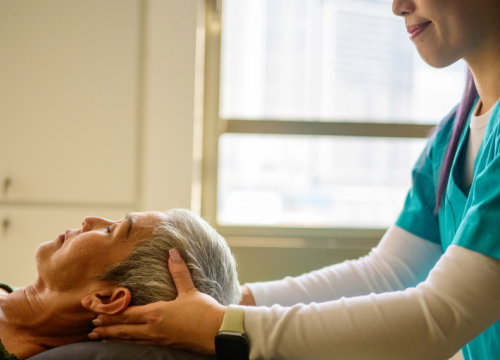Walking with Parkinson’s: Freezing, Balance and Falls

Parkinson’s disease (PD) can change the way a person walks. Movement Symptoms like stiff muscles, rigidity and slow movement make it harder to take normal steps. In fact, short, shuffling steps are a common sign of PD, as is freezing, the feeling that your feet are stuck to the floor, for people with mid-stage to advanced PD.
On their own, these changes are distressing enough. But add the fact that Parkinson’s affects balance and they also become dangerous, putting people with PD at risk of falling. The good news is that with exercise and physical therapy, people with PD can improve their balance. What can you do to minimize freezing and avoid falls? Read on to find out.
The following article is based on the latest research and a Parkinson’s Foundation Expert Briefings about Parkinson’s-related freezing, balance and falls hosted by Fay B. Horak, PhD, PT, Professor of Neurology at the Oregon Health & Science University, a Parkinson’s Foundation Center of Excellence.
Freezing of Gait
Freezing happens when your feet stop moving forward while you are walking, even though you try to keep going. It can be brief and happen erratically. Many people experience freezing as they approach a narrow space, like an elevator door. Usually the legs do not stop moving, instead they tremble or the knees move. This happens because during freezing a person rapidly shifts their weight from foot to foot to take a step.
Trouble With Turning
For people who experience freezing, turning in place is difficult. In fact, it is more likely to set off freezing than walking straight. Turning requires quick adjustments to balance and moving your head, upper body and lower body in sequence. If you have rigidity, this is especially difficult to do.
“In my laboratory we have used wearable sensors to measure freezing and turning in people with PD.” Dr. Horak said. “In one study, we put a camera on each participant’s belt and aimed it at their feet, so we could record and count how often they turned during the day. We were surprised to see that people turn more than 100 times an hour, or up to 1,000 times a day. In fact, we all turn more than walk straight.”
Dr. Horak and her team found that people with PD turn significantly more slowly than people without PD, and they take as many as four or five steps to make a turn. In addition, people with more advanced PD avoided making turns. When they did, they made them slower.
Ultimately, Dr. Horak’s team discovered that a person’s risk of falling can be predicted based on the way they made turns. People who made slower turns and took more steps were more likely to fall. Freezing, turning, shortened steps and falls all are related to balance.
Balance and the Brain
Difficulties with balance and walking are linked to the brain changes that take place with PD. For people who don’t have PD, balance is automatic, a reflex. But Parkinson’s affects the basal ganglia (a part of the brain essential to balance). To compensate, the brain assigns another brain area — an area used for thinking — to take over. The thinking part of the brain, mainly the frontal cortex, can’t control balance automatically. The result: for many people with PD, balance becomes less automatic.
This means that when people experience freezing and fall, they can’t adjust their balance automatically. Taking small steps to try and regain balance can make things worse, because it involves shifting weight with each step. The brain changes from PD inhibit their ability to take a big step to catch their balance and avoid a fall. For some, the drug levodopa (Sinemet) can help prevent freezing, but does not improve balance.
A person whose balance is less automatic must pay more attention while walking. For everyone, walking slows down when we’re talking and thinking slows down when we’re walking. This is called the “dual-task cost” and it’s higher in people with PD. That tells us that people with PD are using more attention and more cognitive control for balance and gait.
Dr. Horak has used brain-imaging techniques in her lab to show how balance signals are rewired in the brains of people with PD, compared to scans of people without PD. The ideal situation is for a person with PD to walk with no distractions. Additionally, people with PD can find that using a walker may require additional attention. To date, deep brain stimulation (DBS) has not been shown to help freezing.
The Route to Better Walking
The good news for people with PD is that with exercise and physical therapy it is possible to cope better with freezing, turn and walk more normally and improve balance. Through practice and sessions, a physical therapist can help people with PD avoid tripping by helping them learn to take larger steps. Additionally, joining an exercise class tailored to people with PD can help. If you take levodopa, be sure to exercise while it is working — the drug helps your body learn and remember motor skills.
Tricks that can help overcome freezing:
- Walk to a regular beat to help prevent freezing. Try a metronome.
- Take large, voluntary marching steps.
- Step over an imaginary line or laser pointer.
- Work with a therapist to find the solution that works best for you.
People respond differently to audio, visual or sensory cues. Dr. Horak and her team are testing a device that provides sensory feedback — vibration on the foot — to stimulate automatic stepping.
Another consideration for people who have freezing is anxiety, a common PD symptom. People who have anxiety experience freezing more often. It is a vicious circle — being anxious about freezing can trigger it. Treating anxiety may help freezing.
To Prevent Falls, Exercise
Exercise is the only intervention that significantly reduces a person’s risk of falling, among older people without PD as well as people with Parkinson’s. Research is beginning to show how exercise changes the brain for the better and can help people with PD gain back some of their automatic balance reflex.
In a study, Dr. Horak and her team asked participants with PD to stand on a quickly moving treadmill, until they began walking. Participants initially took too-small steps, but with one hour of practicing, they improved, taking bigger steps to stay balanced while walking.
Many kinds of exercise can improve a person’s balance. Consider trying:
- Tai Chi: a moving meditation where movements involve shifting the body’s center of mass back and forth over the feet. Studies found fewer falls among people with PD who practiced Tai Chi three times a week.
- Dance: to dance tango, a person has to walk backward and sideways, take big steps and both follow and lead — good ways for people with PD to practice balance control.
- Boxing: the rapid arm movements provide good balance training.
- Agility boot camp: completing different tasks in a series of stations can improve balance.
What is the best exercise? The one you actually do. Choose exercise that makes you sweat and do it three times a week. As you get better, make it more challenging. According to the Parkinson’s Foundation Parkinson’s Outcomes Project, increasing physical activity to at least 2.5 hours a week can slow decline in quality of life.
Tip: People with PD may have other medical issues that affect their ability to exercise, such as arthritis or neuropathy. Work with a physical therapist to find an exercise that suits your needs.
Conclusion
Changes in the brain that take place with PD affect a person’s balance. This, combined with difficulty walking because of stiffness, freezing or shortened steps, puts people with PD at risk of falling. No medications are effective for these issues. Only exercise has been proven to help. Find ways to exercise that you enjoy, get help if you need it and walk with more confidence.
Learn More
- Parkinson.org/Freezing
- Parkinson’s: Substantial Matters podcast on freezing
- Call our Helpline at 1-800-4PD-INFO (1-800-473-4636) to find a Parkinson’s-tailored exercise class or physical therapist in your area.
Related Blog Posts


Start 2026 Strong: Simple Resolutions for Better Health
